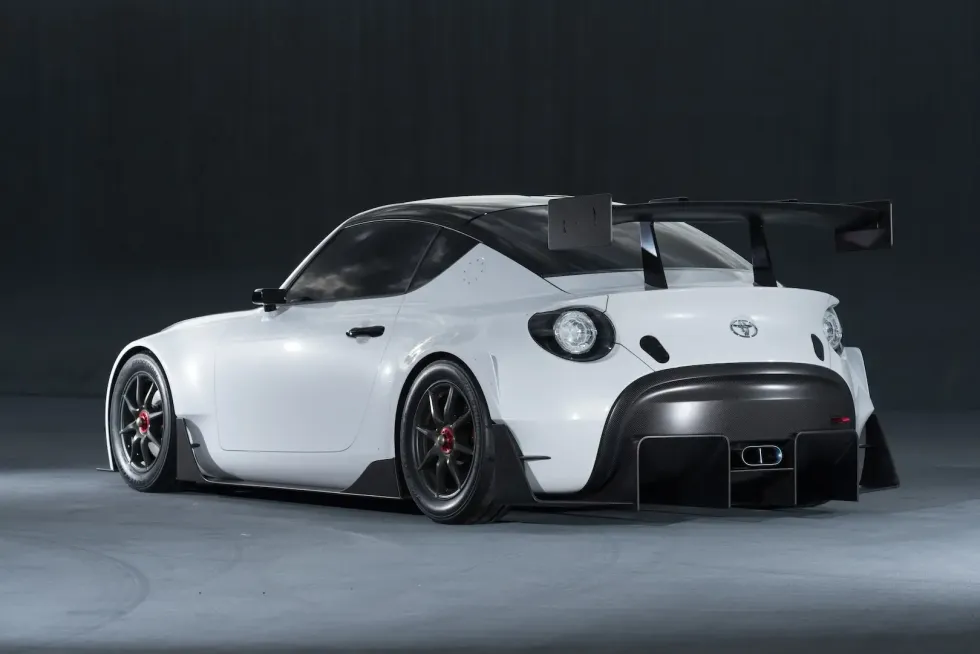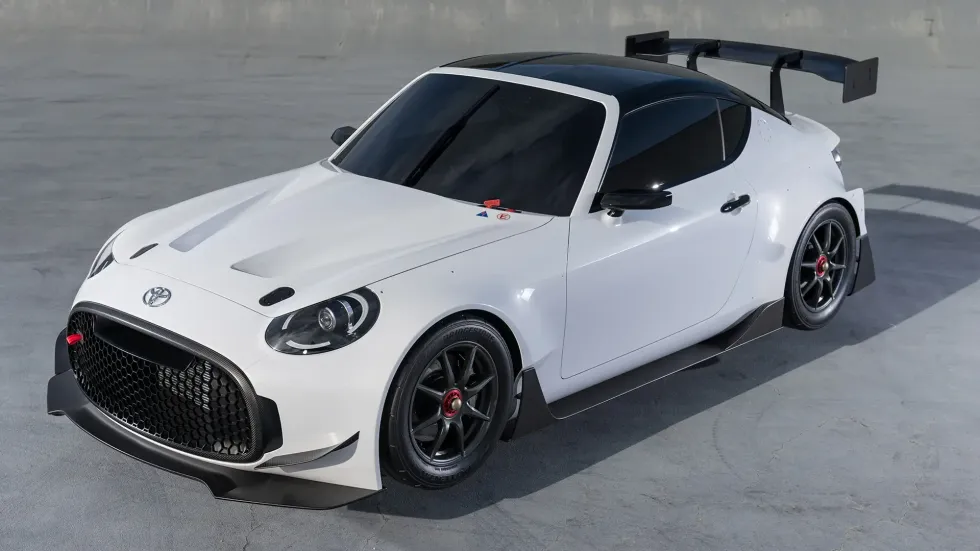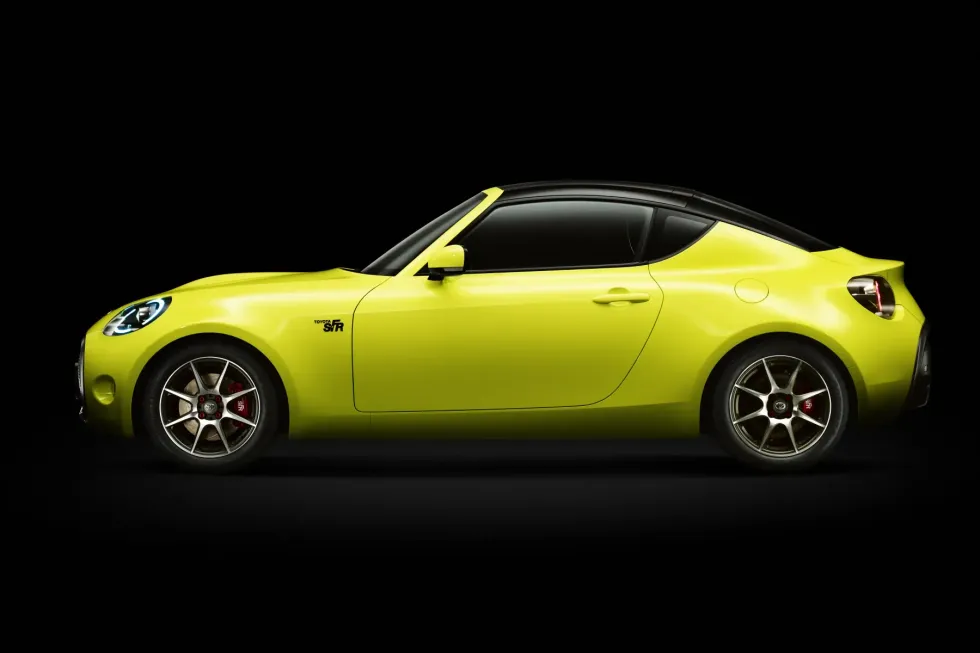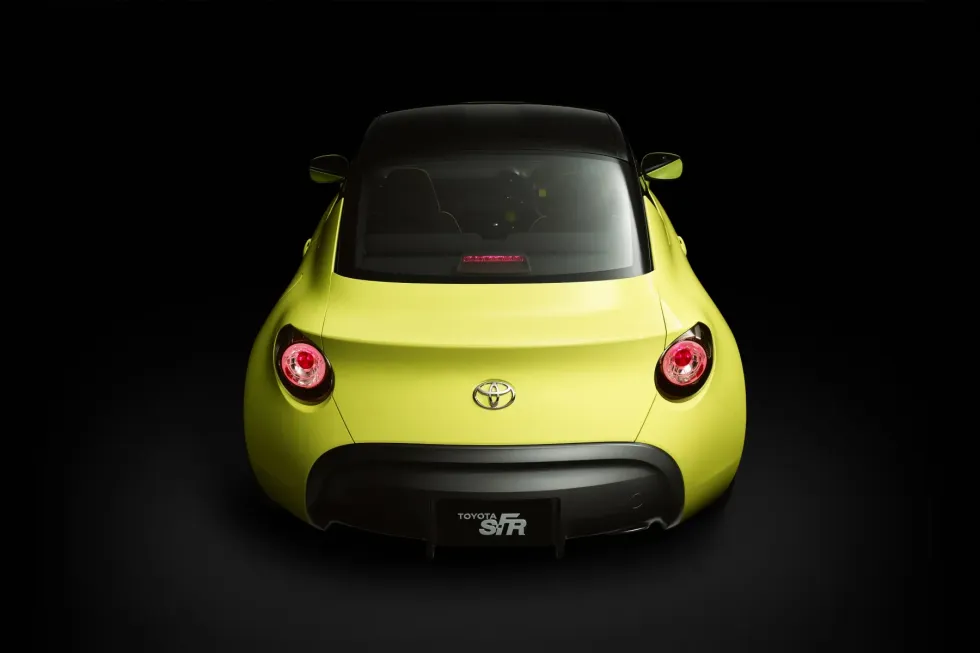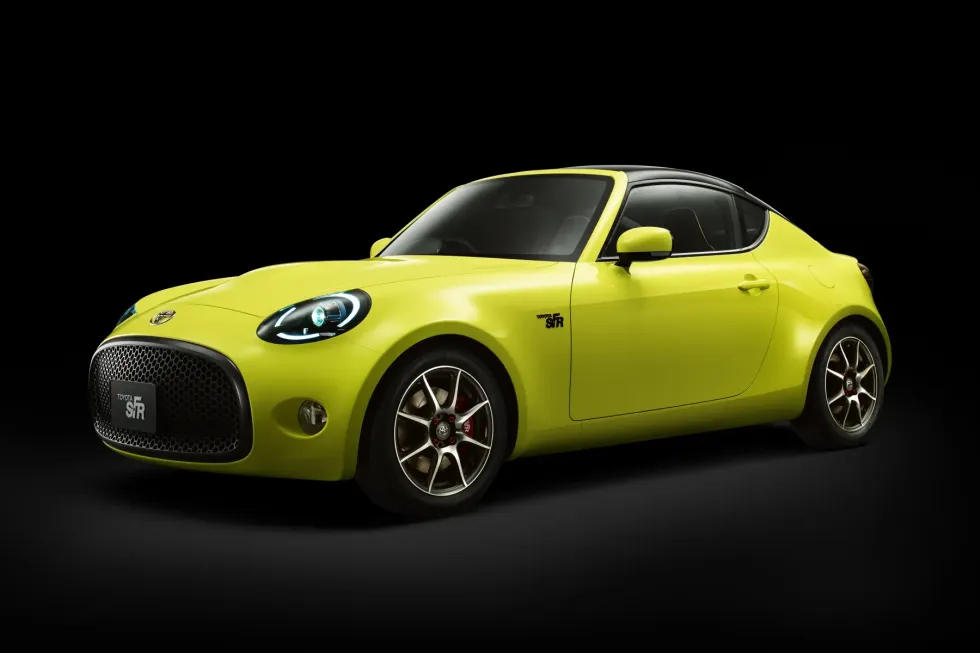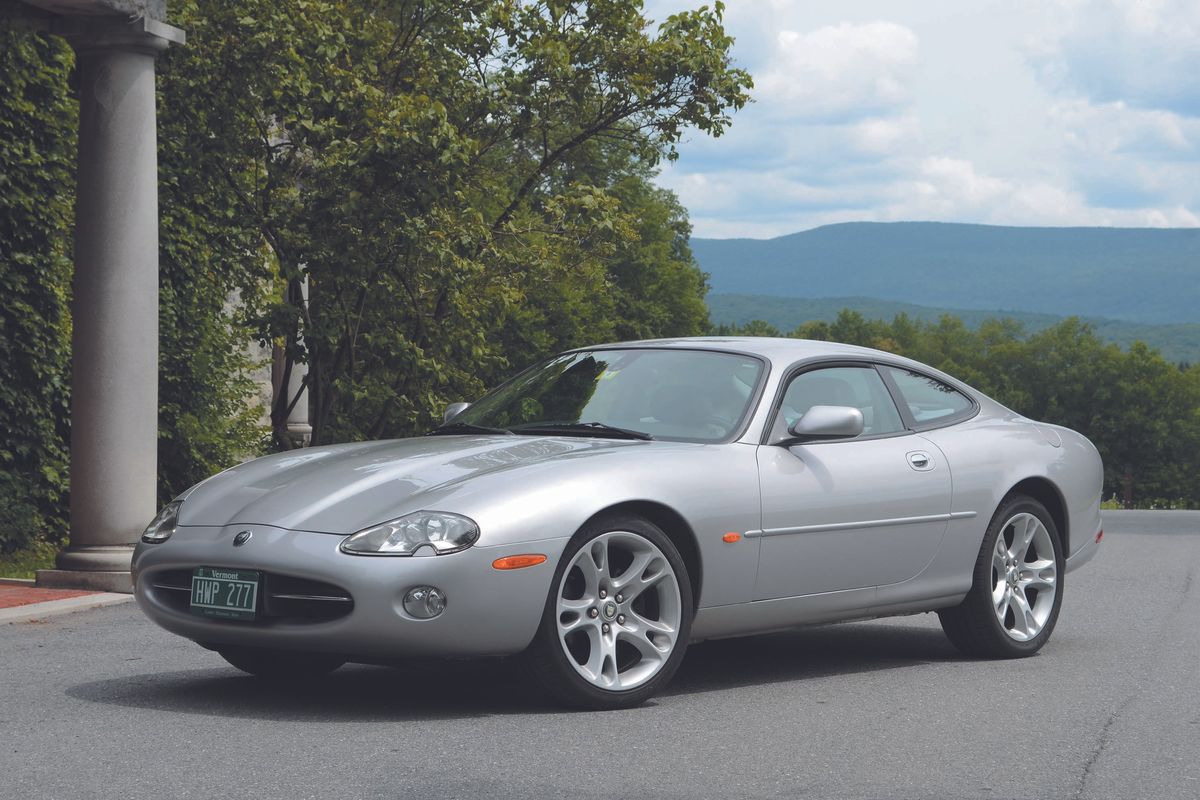
Buy
Resources
Entertainment
Magazine
Community
Considered a modern classic since its unveiling more than a quarter-century ago, the Jaguar XK8 offered the well-heeled buyer a heady cocktail of high performance, a sumptuous interior for two, and head-turning styling in both coupe and convertible form. That's all still true today, with the exception that the buyer's wallet can be considerably thinner. Though it's old enough to be considered a true collector car, the XK8 can still be found at used-car prices, with nice examples available at the northern end of four figures.
For enthusiasts who had spent decades debating whether the XJS was a fitting successor to the drop-dead-gorgeous E-type, the XK8 was a welcome return to the kind of voluptuous lines that had defined Jaguar for decades. The purists did have something new to chew over, though: Unlike its straight-six and V-12 predecessors, the XK8 broke with tradition with its 290-hp, all-aluminum, 32-valve V-8, a configuration Jaguar had never before used.
One remnant of its past that Jaguar Cars was trying hard to shed was its reputation for poor quality, a hangover from the dark British Leyland days. Ford had spent $2.38 billion to acquire Jaguar in 1989, and then poured in countless more dollars to try to reverse the brand's slide toward oblivion. One place those investments could be seen was in the XK8, codename Project X100, the first new Jaguar wholly designed under the Blue Oval's ownership.
“The cat is back,” Jaguar proclaimed in its promotional materials, which heavily emphasized the new car’s slinky curves. “In a single leap, the XK8 reclaims Jaguar's domain amongst the world's most exciting, high-performance sports cars. Every graceful line expresses dynamism and instinctive poise. Every effortless movement confirms the XK8 as the most perfectly evolved sporting Jaguar ever.”
From the start, Jaguar's engineers hit the bullseye on driving dynamics, with 95 percent of respondents to a 1998 Motor Trend survey rating acceleration above average, and 100 percent agreeing that handling was also above average. “It makes driving just for the sake of driving fun again,” one owner wrote. A Porsche 911 it is not, however — with a curb weight of nearly two tons, a 101.9-inch wheelbase, no manual transmission option, and somewhat overboosted power steering, it’s correctly cast as an athletic boulevardier and long-distance cruiser, rather than a sports car.
In November 1999, Jaguar let loose the XKR, which boasted a supercharged, 370-hp version of the V-8 under its louvered hood, enabling a Porsche-Boxster-S-challenging 0-60 mph dash of 5.2 seconds and an electronically limited top speed of 155 mph. Both the XK8 and the XKR were available only with automatic transmissions. Priced at $64,900, or $69,900 in convertible form, the XK8 was competitive with the Porsche 911 Carrera 2, and a bargain compared with the $89,900 Mercedes-Benz SL 500 and $126,300 Aston Martin DB7. From 2003, displacement grew to 4.2 liters, with output raised to 300 hp, or 400 hp in supercharged form.
The cars did suffer some teething pains, notably with Nikasil-lined cylinder bores that could not cope with the then-high levels of sulfur in gasoline, and the unrelated tendency of timing chain tensioners to fail. Both were addressed by the factory, but not before lasting damage had been done to the new model's reputation. Perhaps as a result, resale values are still depressed, though this slinky cat may finally be clawing its way up the appreciation curve.
Over 10 production years, there were 90,064 XK8s and XKRs built, with convertibles outnumbering coupes by a factor of two to one. Production peaked at 14,929 in 1997, the second full year of production, and steadily tapered off to just 3,445 in 2005, the models' final year. There were many special editions, in addition to a variety of colors and specifications. If you think it might be time to put one of these in your garage, here are some things you'll want to know.
Body

Photo: Courtesy of Mecum Auctions
The XK8 and XKR are not immune from rust, and a badly rusted car might look good from the outside. Start your inspection with the front floorpans, which are highly susceptible to corrosion, thanks to steel plates under the front footwells that trap moisture. Replacement pans are available, but installing them is a lot of work.
With the front wheels at full lock, shine a light into the wheelwell to look for corrosion of the chassis legs behind the subframe turrets. While you're there, you can check the subframe V-mounts, engine mounts, and suspension bushings. Turn the wheel full lock and repeat on the other side.
The rear of the rocker panels is a notorious corrosion spot, where the design causes them to catch and hold debris and moisture. Repair panels are available in the aftermarket. The front section of the rockers is also vulnerable, to a lesser degree. If the vehicle you're buying has sound rockers, be sure to keep this area clean to prevent future problems.
Check the wheel arches all the way around for bubbling — these collect debris, too. The area behind the rear wheel and above the bumper is also prone to rot. While at the rear, check the bumper mounts, which frequently corrode. As with any potential purchase, give the bodywork a careful look over for poor repairs.
If you're considering a convertible, make sure that the power top works correctly. The system’s CHF11S hydraulic fluid can congeal and block the lines if it isn't flushed every six years; this can cause the top to stick. Check the condition of the material, and the heating elements in the rear glass; a new top, without a window, will cost the better part of $1,000, and that doesn't include installation by your local body shop.
Engine

Photo: Jaguar
The AJ-V8 was Jaguar's first V-8 design, and just the fourth all-new engine developed by the automaker in its long history. It was part of a family of V-6, V-8 and V-12 engines Jaguar had envisioned in the late 1980s as replacements for the existing inline-six and V-12. When Ford took control, it was decided to pursue only the V-8 version, to power the existing "X300" XJ6 sedan and the sports car project that would become the XK8.
Bore and stroke were both set at 86 mm, giving a displacement of 3,995-cc. There were two overhead camshafts for each cylinder bank, and the heads and block were of aluminum. Hollow, one-piece cast camshafts acted directly on the aluminum bucket tappets. To avoid the periodic replacement that a timing belt would require, the intake cams were driven by a pair of long, single-row chains, with the exhaust cams driven by the inlet cams via shorter chains. Jaguar's Variable Valve Timing system was incorporated, with an actuator on each intake cam operated by a pair of electronically switched oil-pressure control valves. The crankshaft was made from spheroidal graphite cast iron, to which were attached fracture-split, powder-forged connecting rods.
A supercharged version of the V-8 was introduced in May 1998 for the XKR model, launched in coupe and convertible form in the U.S. in November 1999. The engine employed an Eaton M112 unit and twin intercoolers to provide 11.9 pounds of boost, adding 80 horses to the 290 of the normally aspirated engine. Dished pistons, made of high-strength aluminum alloy, were used to reduce the compression ratio to 9:1. Distinguished by its hood louvers, mesh grille, and trunklid-mounted spoiler, the XKR was the fastest roadgoing Jaguar to date.
For 2003, the XK8 and XKR received the stroked, 4.2-liter version of the V-8, which had been introduced the year before in the S Type sedan. Power levels rose to 300 hp in normally aspirated form, and 393 with supercharger.
From the outset, the AJ-V8 ran into reliability problems. Cylinder bores were originally coated with Nikasil, a nickel-silicon-carbide material used to prevent wear of the aluminum block, but the coating proved vulnerable to attack from low-grade, high-sulfur fuels. This led to excessive wear in the bores, causing low compression and hard starting. Jaguar switched to traditional cast-in steel cylinder liners, and supplied new engines under warranty for vehicles that were suffering from Nikasil issues.
Jaguar honored warranty claims for all vehicles built before the start of the 2000 model year. To be certain of what you're looking at, check the engine number — steel liners were introduced with engine number 008181043. If an engine has been replaced under warranty, you should find a green "Genuine Jaguar Exchange Product" plate behind the right-hand cylinder head. What if the car you're looking at still has its original Nikasil engine? It might still be in good condition, if it avoided damage in its early years. Gasoline sold today has a much lower sulfur content and is unlikely to create problems.
These engines have also been beset with timing chain tensioner failures, with the plastic used in the hydraulic tensioners tending to disintegrate over time. The immediate result is a rattling sound from the front of the engine at startup as the chain contacts the metal face of the tensioner. Ultimately, if there's enough slack, the chain will jump a tooth. One tooth will make the engine run roughly, while two will result in the catastrophic collision of valves with pistons. Jaguar introduced a second-generation plastic tensioner, which was ineffective, and then beginning with the 2002 model year replaced that with a metal-bodied tensioner, which cured the problem. The metal tensioner was introduced with engine number 0108130000. It's important to remove the cam covers for a visual inspection to ensure that the car you're considering has the right tensioners. If not, budget at least $3,000 for the work, and don't put it off.
Transmission

Photo: Hemmings Auctions (Courtesy: The Motor Venue)
To the everlasting disappointment of three-pedal fans, Jaguar never offered a manual transmission with the XK8. Initially, a ZF 5HP24 five-speed automatic was used with the normally aspirated 4-liter engine, with the supercharged XKR getting a Mercedes-Benz W5A580 five-speed automatic. When the 4.2-liter was introduced, both engines were mated to a new ZF 6HP26 six-speed automatic. Jaguar used its trademark “J gate” gearshift, enabling the driver to prevent the transmission from shifting up from a selected gear.
The Mercedes-Benz and six-speed ZF transmissions have proven to be relatively bulletproof, but owners have reported problems with the five-speed ZF. These include hesitation at takeoff, caused by the failure of a clutch drum; difficulty in engaging reverse, due to a misaligned valve; and failure to engage reverse, caused by a defective clutch piston. Beyond that, problems with the operation of these electronically controlled transmissions can often be traced to poor connections.
Although Jaguar claimed that its transmissions were sealed for life, specialists recommend that the fluid and filter be replaced every 50,000 to 60,000 miles. The usual cautions with an automatic transmission vehicle apply: Look for signs of gear slippage or jerkiness in shifting, which might indicate that the unit is near the end of its useful life, and check for signs of fluid leaks.
Chassis and Brakes
The XK8 is of unit-body construction, with independent suspension at all four corners. Up front, a hefty, cast-aluminum crossmember supports the double-wishbone suspension, which uses coaxial springs and shocks. In the rear, suspension components are mounted to a subframe, using a design borrowed from the successful X300 XJ6 sedan. The wheels are located by lower control arms and the axle shafts, which function as upper control arms. Typical wear items include wheel bearings, bushings (the XK8 has more than its share), ball joints, and shock absorbers.
You may find a car equipped with the optional Computer Active Technology Suspension (CATS) system. CATS manages and optimizes ride and handling through the use of stiffer springs and electronically adjusted shock absorbers that react to conditions. When set up properly, the system works well. Problems arise when the electrical connections between the shocks and the wiring harness fail; the shock will sometimes rotate, pulling the connector off. Replacing components in the rear suspension can be a time-consuming job.
Front suspension bushings are another potential trouble spot. These can collapse in as little as 10,000 miles, affecting ride and handling. If the gaps between the fenders and the wheel tops are not equal front and rear, suspect collapsed bushings. A knocking sound from the front can be a sign that the top wishbone bushings have seized to the fulcrum pin, leading the assembly to wear against the aluminum crossmember. This may require replacement of the crossmember with a new or good used part.
Four-wheel disc brakes with ABS were standard on the XK8 and XKR. The diameter of the brake discs was changed in 1999 from 305 mm to 325 mm, potentially giving these cars superior braking ability. Failures in the ABS system can be caused by broken solder joints in the control module; there are a host of videos on YouTube to walk you through a DIY repair.
Check for Jaguar wheels and good quality tires; this is often an indicator of the kind of care a car has received. Seventeen-inch wheels with Pirelli P-Zero 245/50ZR17 tires were fitted on XK8s at the factory; XK8s with CATS and XKRs got 18-inch wheels with Pirelli 245/45ZR18s at the front and 255/45ZR18s at the rear. Optional at extra cost were 19- and 20-inch wheels. A space-saver spare was supplied.
Interior
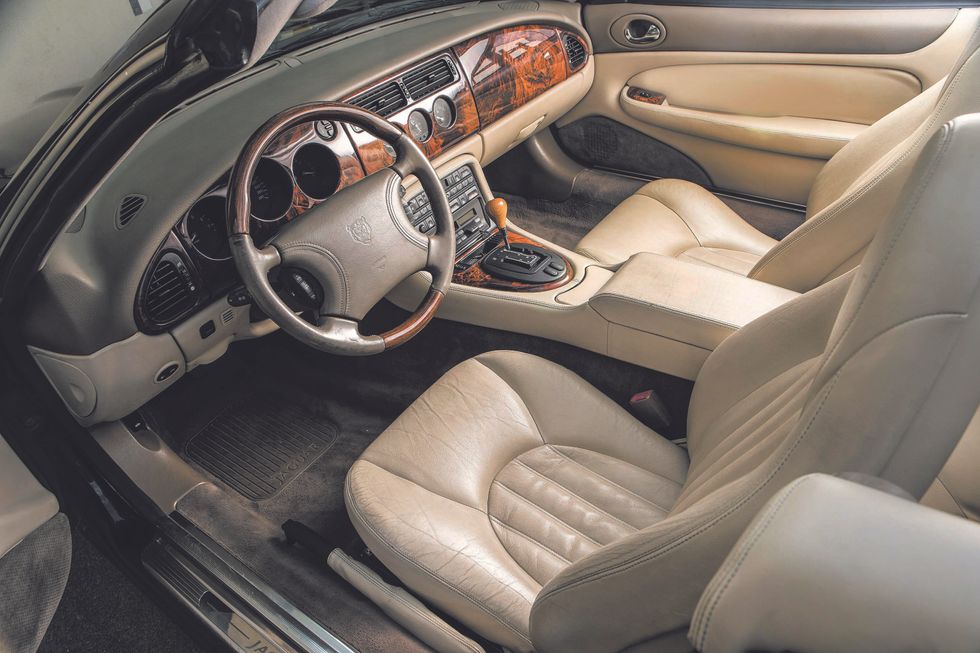
Photo: David LaChance
Jaguar founder William Lyons was a genius when it came to making customers feel that they had gotten more than they'd paid for, and that approach continued with the X100 models. The interior was offered in two trims: Classic, which most buyers chose, and Sport. The Classic interior, available in Oatmeal, Charcoal, Cream, or Teal, offered a color-coordinated dashboard; full leather upholstery; burr walnut wood veneer on the dashboard, console and doors; and a wood-and-leather steering wheel. The Sport interior, offered in Oatmeal, Charcoal, or Cream, featured a Charcoal dashboard, steering wheel, and leather key fob, and cloth-and-leather seat upholstery, with all-leather optional. Carpets were color-keyed in the Classic, and black in the Sport.
A six-way power driver seat was standard, as were a trip computer, automatic climate control, heated door mirrors, an auto-dimming interior mirror, an 80-watt audio system with cassette, and adjustable steering column. A power tilt steering column, cruise control, a six-CD trunk-mounted changer, and two-position memory for the driver seat were popular options.
The upholstery tends to wear well, with any damage typically limited to the outer bolster of the driver seat. New front seat covers are available. The rear seat is often in as-new condition, as it’s really too small for human habitation, despite the fact that these cars were marketed as 2+2s — think of it as a nicely finished cargo area. On coupes, the headliner tends to sag; replacement upholstered headliner panels are available. The resin finish on wood parts can crack in certain climates; these can be professionally refinished, or replaced with undamaged used parts. Budget $1,000 to have all the wood stripped, repaired, and refinished.
Check to make sure that the fob-operated central locking system works. If the fob can't communicate with the car, you may need a new ECU; since these are no longer available from Jaguar, your only options may be an expensive used unit, or using the key to manually lock and unlock the doors.
What To Pay: Low, Average, High
- XK8 convertible $5,200 $7,875 $9,950
- XK8 coupe $4,700 $7,200 $9,150
- XKR convertible $6,475 $9,800 $12,300
- XKR coupe $6,000 $9,200 $11,800
Parts Prices
- Alternator $1,180
- Top boot cover, vinyl $764
- Brake rotor, front $100
- Bumper cover, front $1,767
- Headlamp assembly, composite $903
- Seat cover set, front, leather $1,667
- Shock absorber, without CATS $315
- Supercharger, remanufactured $4,609
- Timing chains and tensioners, complete kit $495
- Upper suspension mount, front $238
- Water pump assembly $260
- Wheel, 17-inch, refurbished $195
- Wheel bearing $96

Photo: David LaChance
Jaguar produced several special editions of the X100 over its production run. Among those offered in the North American market were:
Silverstone: In celebration of the brand's return to Formula 1 racing, 250 special edition XK8s were sent to the U.S. for 2001. These were finished in Platinum Silver with a black leather interior.
XKR100: To mark the centenary of the birth of Jaguar founder William Lyons, the company created 500 examples of the XKR 100, with Anthracite paint, Warm Charcoal interiors, nine-spoke BBS alloy wheels, and cross-drilled Brembo brakes.
XKR Portfolio: Offered only as a convertible, the Portfolio featured red or blue paintwork with matching Recaro sport seats and interior.
Victory Edition: Jaguar celebrated its four championships in the North American Trans-Am road racing series with special interior trim, accents, and badging, which included a hood-mounted "growler" badge with checkered-flag emblems. Production totaled 1,050, and included XKR and XK8 coupes and convertibles.
Carbon Fiber Edition: Offered only on the XK8 convertible, the 2005 Carbon Fiber Edition was an appearance package that featured carbon fiber dashboard, console, and door accents in place of the usual wood. Four color combinations were offered: Ebony exterior over Charcoal interior; Platinum exterior over Ivory interior; Platinum exterior over Charcoal interior, and; Slate exterior over Dove interior. Just 200 were built for the U.S. market.
Recent
Toyota
Toyota is pulling out all the stops to compete with the likes of affordable sports cars like the Mazda Miata. The automaker reportedly plans to put the S-FR concept car, originally debuted in 2015, into production. With potential release dates slated for early-2026 or early-2027, perhaps Miata may not always be the answer.
A new report out of Japan confirmed that the Toyota S-FR concept, first seen at the 2015 Tokyo Motor Show, will hit the market to challenge the entry-level sports car segment. Forbes backs up this claim via its print edition of Best Car. According to the report, the Toyota S-FR will be produced in partnership with Daihatsu, a wholly owned subsidiary of Toyota, and Suzuki, of which the Toyota Motor Corporation owns 4.94 percent.
From the sounds of it, the S-FR will share a platform with the Daihatsu Vision Copen that was revealed at the 2023 Tokyo Mobility Show. It will supposedly feature the same two-plus-two seating as displayed in the concept, but will be even smaller and lighter than the Toyota 86 model.
The Toyota S-FR will reportedly get its power from a turbocharged three-cylinder engine that will send around 150 horsepower to the rear wheels. If these figures sound familiar, you may have also heard the rumors about Toyota reviving the Starlet with a GR performance version that has similar specs; a 1.3-liter engine producing 150 horsepower.
Like most concept cars, the S-FR’s design will see some changes before production, in this case reports point specifically to a smaller grille and altered headlights. Whether or not the production model will incorporate the concept’s aero elements is unknown.
Toyota’s target MSRP of $22,700 for the S-FR could potentially beat out the Mazda Miata by around $6,000. Whether or not the S-FR will be sold in the States to potentially compete with Toyota’s existing GR86 model’s sales is also, sadly, unknown, but we have our fingers crossed.
Keep reading...Show Less
Toyota
JDM fans rejoice: A recent report out of Japan states that Toyota could be adding to its GR lineup with a front-wheel drive Toyota Starlet hatchback. The reborn Toyota Starlet will reportedly join the ranks of the existing GR Supra, GR 86, GR Yaris, and GR Corolla models.
Built in partnership with Gazoo Racing, Toyota’s motorsport division, the new Starlet will reportedly be built as a rally-focused machine, which makes sense when you consider Toyota’s history in the Rally 4 class. The terrain-dominating Starlet hatchback would compete against Toyota’s rally rivals, such as the Ford Fiesta, Renault Clio, and Peugeot 208.
This information comes from the Japanese car information magazine Best Car. Of course, the production Starlet GR wouldn’t have the rally car’s wide fenders and aggressive aerodynamics, but both versions would likely be powered by a 1.6-liter or 1.3-liter turbocharged three-cylinder engine. It’s our hope that it would be offered with the choice of a six-speed manual transmission or an eight-speed automatic, which would send around 150 horsepower to the front wheels. The subcompact hatch will supposedly weigh in at a mere 2,160 pounds, 727 pounds lighter than a Yaris GR.
The new Toyota Starlet could reportedly fetch between 2.5 million yen and 2.8 million yen, around $16,000 and $18,000, respectively, but if it does go into production, don’t expect to see the model hit the U.S. market anytime soon.
Keep reading...Show Less

